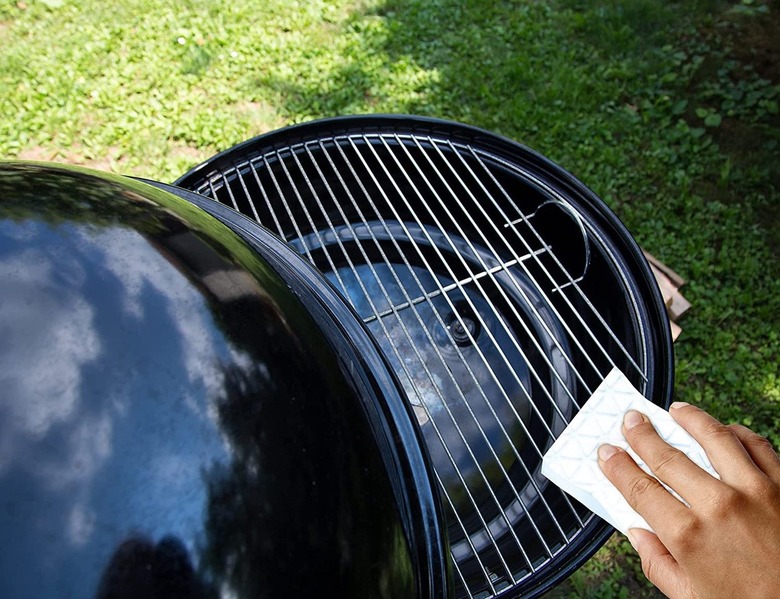Is The Mr Clean Magic Eraser Actually Dangerous?
If you're going to call your product "magic," you're going to create some extremely high expectations. And Procter & Gamble delivered with the Mr. Clean Magic Eraser, which has become one of the most reliably beloved cleaning products on the market. Who would have guessed that an ordinary-looking block of white foam would be so effective at removing stubborn marks on so many different surfaces? But while the Magic Eraser has been a cleaning game changer, some people have heard that they might be dangerous. Luckily, they're safer than a lot of the other cleaning products that are probably already in your home.
What Is Mr. Clean Magic Eraser Made Of?
Procter & Gamble lists just one ingredient for Mr. Clean Magic Erasers and Mr. Clean Magic Eraser sheets: melamine resin foam. It feels soft in your hand, but on a microscopic level, melamine foam has an abrasive sandpaper-like texture that breaks down dirt, grime, and stains.
Bear in mind that Mr. Clean makes several varieties of Magic Eraser products, which may include fragrances and other chemical additives not used in the original Magic Erasers or Magic Eraser sheets.
Is Mr. Clean Magic Eraser Actually Dangerous?
A lot of the confusion around the dangers of Mr. Clean Magic Eraser comes from the fact that melamine is made using a compound called formaldehyde-melamine-sodium bisulfite copolymer. People are understandably nervous when they hear "formaldehyde," but it's entirely safe when used as part of this compound. There's no evidence that Magic Erasers pose a health risk to people who use them the right way.
That said, because they're so abrasive, vigorously rubbing a Magic Eraser on the skin could certainly cause irritation. Never try to use a Magic Eraser to clean or exfoliate the skin. Kids shouldn't be allowed to have access to them for this reason; their curiosity about what that "magic" little brick can do could end with blood. And anyone who's sensitive to fragrances should stick to original Magic Erasers and avoid the ones with additives. Or wear gloves while cleaning to avoid direct contact with the Magic Eraser on skin.
Apart from using a Magic Eraser on skin, the biggest threat this sponge poses is to your home's delicate surfaces. Melamine foam can scratch paint, sealants, and certain relatively soft materials like wood and marble. These sponges shouldn't be used on anything you think would be ruined by fine-grit sandpaper; for example, never clean the outside of your car or nonstick cookware with a Magic Eraser.
Magic Erasers are also fairly harmless from a sustainability standpoint, at least compared to many other cleaning products. The material can't be recycled, but you can essentially use the sponge until it disintegrates.
How Should Magic Erasers Be Used?
There are a lot of unexpected ways to use a Magic Eraser to get your home cleaner. In addition to removing marks from plastic surfaces like light switches, it can be used to clean doors and walls painted with nonglossy paint. (Always do a spot test in a hidden area first.) These sponges can also be used to remove scuffs from white shoes, clean a filthy oven door, and even get stubborn stains out of plastic food containers. You can also use Magic Eraser sheets to get into crevices that the foam erasers can't, like inside a grimy toothbrush holder.
Finally, keep in mind that the magical cleaning power of the Magic Eraser isn't limited to the Mr. Clean brand — you can buy plain melamine sponges in bulk and get the same results.
